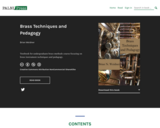
Textbook for undergraduate brass methods course focusing on brass instrument techniques and pedagogy.
- Subject:
- Arts and Humanities
- Performing Arts
- Material Type:
- Textbook
- Provider:
- PALNI Press
- Author:
- Brian Weidner
- Date Added:
- 11/02/2021

Textbook for undergraduate brass methods course focusing on brass instrument techniques and pedagogy.
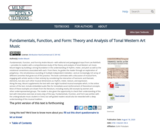
Fundamentals, Function, and Form by Andre Mount—with editorial and pedagogical input from Lee Rothfarb—provides its readers with a comprehensive study of the theory and analysis of tonal Western art music. Mount begins by building a strong foundation in the understanding of rhythm, meter, and pitch as well as the notational conventions associated with each. From there, he guides the reader through an exploration of polyphony—the simultaneous sounding of multiple independent melodies—and an increasingly rich array of different sonorites that grow out of this practice. The book culminates with a discussion of musical form, engaging with artistic works in their entirety by considering the interaction of harmonic and thematic elements, but also such other musical dimensions as rhythm, meter, texture, and expression.
Along the way, Mount supplements the text with over eight hundred musical examples which, in the online version of the text, include embedded audio files for immediate aural reinforcement of theoretical concepts. Most of these examples are drawn from the literature, including nearly 200 excerpts by women and other underrepresented groups. The reader is also given the opportunity to check their understanding of the text with interactive exercises at every step of the way. Fundamentals, Function, and Form was written with the undergraduate music student in mind, but self-guided readers would also be rewarded with a deep understanding of this musical tradition.
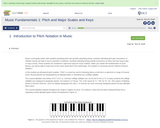
This collection is the first of five dealing with the rudiments of music.
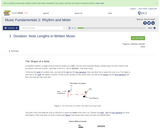
This collection is the second of five dealing with the rudiments of music.
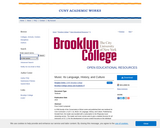
Welcome to Music 1300, Music: Its Language History, and Culture. The course has a number of interrelated objectives:
1. To introduce you to works representative of a variety of music traditions.These include the repertoires of Western Europe from the Middle Agesthrough the present; of the United States, including art music, jazz, folk, rock, musical theater; and from at least two non-Western world areas (Africa, Asia, Latin America, the Caribbean, the Middle East, Indian subcontinent).
2. To enable you to speak and write about the features of the music you study,employing vocabulary and concepts of melody, rhythm, harmony, texture, timbre,and form used by musicians.
3. To explore with you the historic, social, and cultural contexts and the role of class, ethnicity, and gender in the creation and performance of music,including practices of improvisation and the implications of oral andnotated transmission.
4. To acquaint you with the sources of musical sounds—instruments and voices fromdifferent cultures, found sounds, electronically generated sounds; basic principlesthat determine pitch and timbre.
5. To examine the influence of technology, mass media, globalization, and transnationalcurrents on the music of today.
The chapters in this reader contain definitions and explanations of musical terms and concepts,short essays on subjects related to music as a creative performing art, biographical sketchesof major figures in music, and historical and cultural background information on music fromdifferent periods and places.
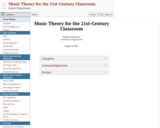
Music Theory for the 21st–Century Classroom is an openly–licensed online four–semester college music theory textbook. This text differs from other music theory textbooks by focusing less on four–part (SATB) voiceleading and more on relating harmony to the phrase. Also, in traditional music theory textbooks, there is little emphasis on motivic analysis and analysis of melodic units smaller than the phrase. In my opinion, this led to students having difficulty with creating melodies, since the training they are given is typically to write a “melody” in quarter notes in the soprano voice of part writing exercises. When the assignments in those texts ask students to do more than this, the majority of the students struggle to create a melody with continuity and with appropriate placement of harmonies within a phrase because the text had not prepared them to do so.
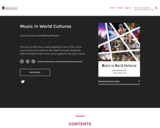
This text provides just a small sampling of some of the various musical styles and traditions that might be found, though the skills developed in this course can be applied to any type of music.
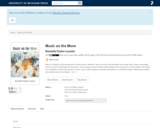
Music is a mobile art. When people move to faraway places, whether by choice or by force, they bring their music along. Music creates a meaningful point of contact for individuals and for groups; it can encourage curiosity and foster understanding; and it can preserve a sense of identity and comfort in an unfamiliar or hostile environment. As music crosses cultural, linguistic, and political boundaries, it continually changes. While human mobility and mediation have always shaped music-making, our current era of digital connectedness introduces new creative opportunities and inspiration even as it extends concerns about issues such as copyright infringement and cultural appropriation.
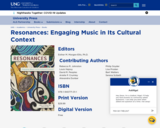
Welcome to Resonances: Engaging Music in Its Cultural Context! Although this book is intended primarily for use in the college music appreciation classroom, it was designed with consideration for independent learners, advanced high school students, and experienced musicians. That is to say, it includes enough detail that expert guidance is not required and is written using broadly-accessible language. At the same time, it addresses advanced topics and positions music as a serious object of study.
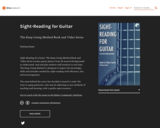
Sight-Reading for Guitar: The Keep Going Method Book and Video Series teaches guitar players from all musical backgrounds to understand, read and play modern staff notation in real time. The Keep Going Method is designed to impart the knowledge, skills and attitudes needed for sight-reading with efficiency, fun and encouragement.
The team behind the series has decided to launch it early. We want to equip guitarists, who may be adjusting to new methods of teaching and learning, with a quality open resource.

Sound Reasoning is a web-based, introductory music appreciation course. It offers a new approach to music appreciation for adults, focusing on style-independent concepts. While the course concentrates primarily on Western classical and modern music, the concepts that are introduced apply to music of any style or era. The goal of "Sound Reasoning" is to equip you with questions that you may ask of any piece of music, thereby creating a richer and more comprehensive understanding of music both familiar and unfamiliar. Here are some additional features of the course. "Sound Reasoning" is completely listening based. No ability to read music is required. The course assumes little or no musical background. A minimum of terminology is invoked. Musical examples are interpolated directly into the text. The course is interactive. A "listening gallery" with exercises follows each module, so that you may practice and refine your listening skills. The modules may be studied in sequence or individually. You may easily print a .pdf of any module. "Sound Reasoning" is designed as both a stand-alone, self-paced course as well as a supplement to existing university classes.
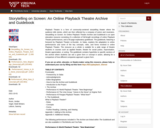
Playback Theatre is a form of community-centered storytelling theater where the audience tells stories, which are then reflected by a company of actors and musicians. Storytelling on Screen: An Online Playback Theatre Archive and Guidebook is an open education resource consisting of a collection of full-length recordings of online Playback Theatre performances, and a 55-page explanatory guidebook. The guidebook, featuring a foreword by Playback Theatre co-founder, Jo Salas, explains the adaptation to online performances and some of the key concepts, roles, and forms involved in online Playback Theatre. The resource as a whole is suitable for a wide range of theatre students in courses such as applied theatre, theatre for social justice, improvisation, theatre appreciation, or acting. The guidebook contains hyperlinks to specific sections of the archive where students can see a given form or concept in action, allowing for a comparison of how different companies approach a given form.
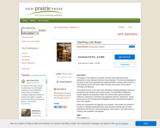
The purpose of this textbook is to provide resources about teaching low brass instruments to music educators and future music educators. The book was developed by the author as part of the open/alternative textbook initiative at Kansas State University. It Is the textbook used for the Kansas State University course Music 239-Low Brass Techniques and Materials.

Welcome to the exciting world of technical theatre. Studying this topic can lead to many different careers in several different sectors of the economy. The general skills needed for any of the careers or sectors have many things in common. Workers need to be dead-line oriented, as most productions have firm timelines that cannot be altered. Critical thinking and analysis are much needed skills. Almost every project in the field is unique and technicians and designers alike must discover the best way of reaching a project’s goal. Creative problem solving is trait successful practitioners have in common. With every project being unique, there are no guaranteed solutions to the problems that are presented. Technicians draw on their vast experience of what worked in the past that can be adapted to be a solution to the current problems. Clear communication and collaboration round out the necessary skills. No technical theatre project is ever handled by one person on their own. Collaboration with many people is the norm, and successful collaboration requires clear written and verbal communication skills.
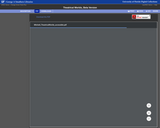
From the University of Florida College of Fine Arts, Charlie Mitchell and distinguished colleagues from across America present an introductory text for theatre and theoretical production. This book seeks to give insight into the people and processes that create theater. It does not strip away the feeling of magic but to add wonder for the artistry that make a production work well.
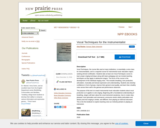
Vocal Techniques, the course title used at many institutions, is essentially a voice class for instrumentalists, and is a required course for instrumental music education majors seeking all-level certification. Students take at least one Vocal Techniques course to learn proper singing technique along with basic pedagogy and can include teaching techniques as they apply to adolescent singers. The focus of the course is the development of the individual singing voice. This includes breathing, tone production, articulation, musicality and textual expression and understanding. Students also develop confidence in front of groups, improve their general vocal quality, and learn that a healthy voice serves them well in the general and performance classroom.